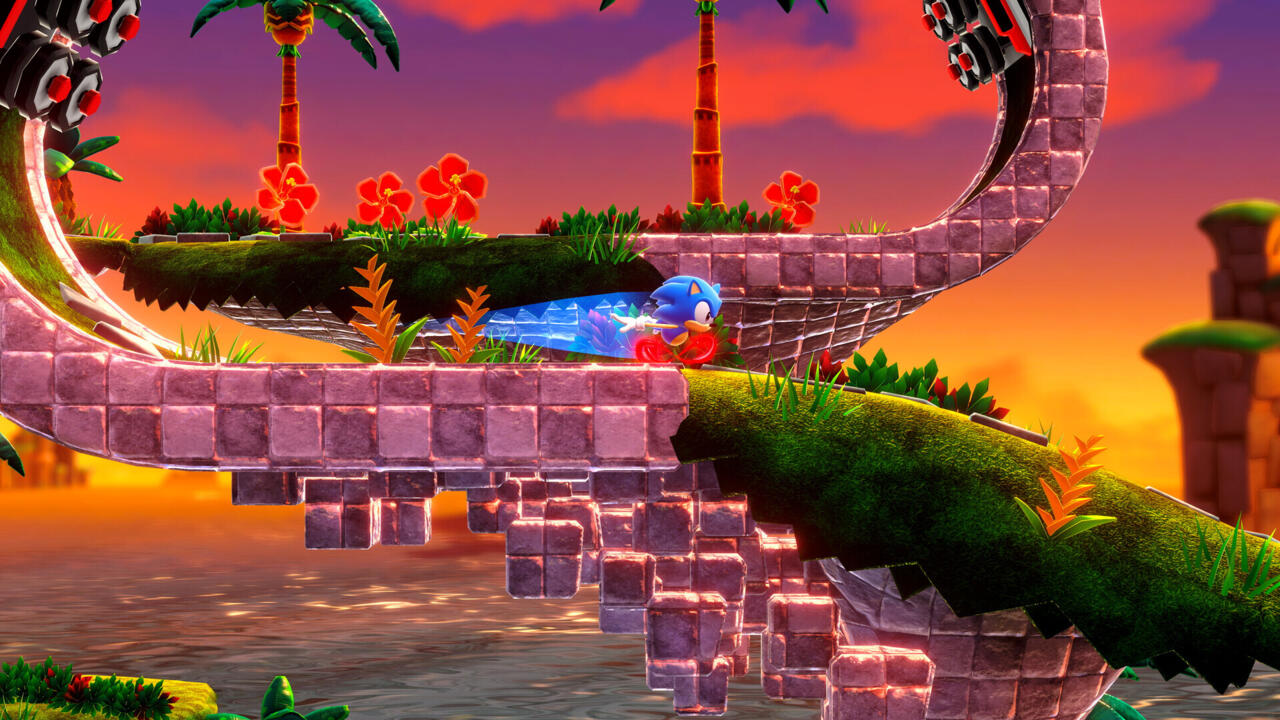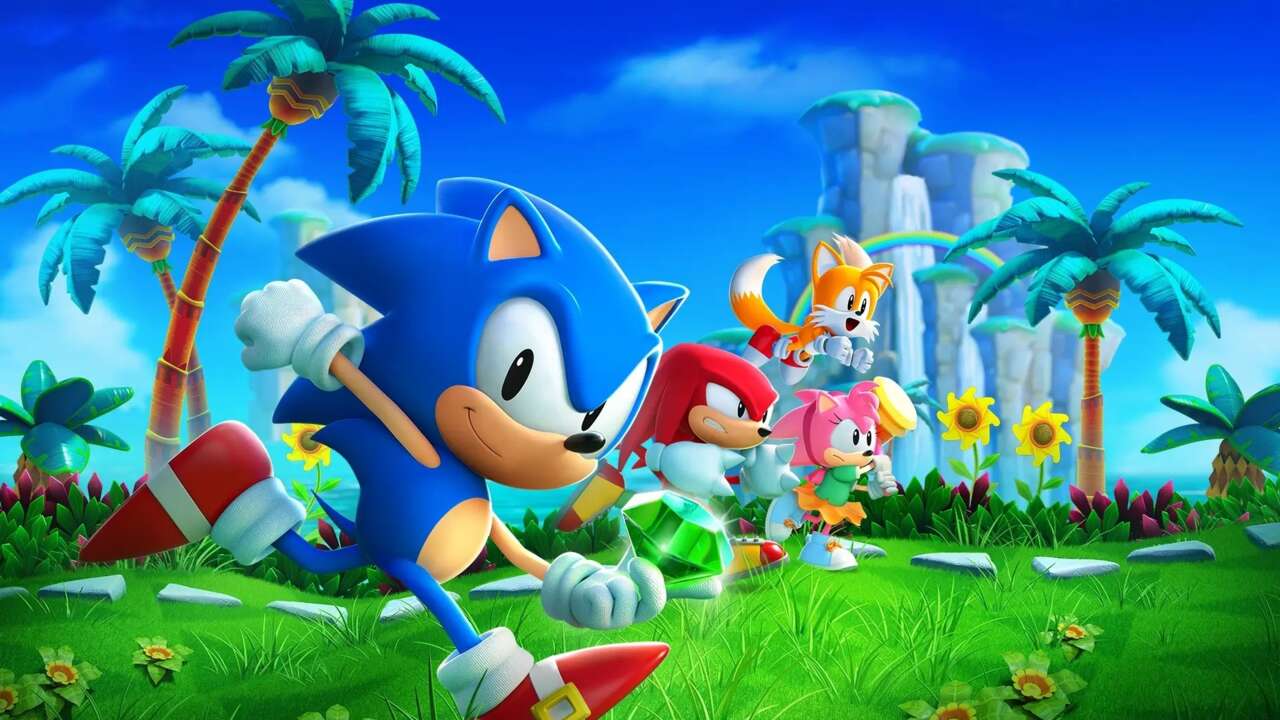Sonic Superstars Review – Reaching for Stars
Sonic as a franchise is notoriously inconsistent, offering up some amazing highs, some truly dire lows, and a fair few games that are forgettably mediocre. But then there’s that one weird category several Sonics fall into: games that are obviously, undeniably flawed in some way, but still have that something that makes a Sonic game feel special. Maybe not everyone can feel what makes them great, but for others, those qualities will overshine all of the negatives. Sonic Superstars is one such game, one with glaring flaws that I happen to like a lot.
We all know how it goes by now: Sonic’s arch-nemesis Dr. Eggman is up to no good, and he’s got his eye on a new locale whose resources he can exploit for evil schemes. It’s up to Sonic and his BFFs, Tails, Knuckles, and Amy, to stop the Doctor, recover the Chaos Emeralds, battle the returning but obscure fan-favorite villain Fang the Sniper, and meet a brand-new buddy to save the day. Accomplishing this task involves zipping through 11 themed side-scrolling zones while collecting rings, bonking Badniks, and dealing with each area’s distinct gimmicks and threats. No melodramatic story scenes, RPG or sim elements, or awkward romances here: It’s pure, classic Sonic platforming.
That doesn’t mean it’s entirely devoid of new ideas, however. All of the zones are brand-new: Familiar elements from previous games like gimmicks and enemies might return, but every stage is an original. Collecting a Chaos Emerald now grants a special Emerald Power players can put to use at almost any time, provided they have the energy for it. And–perhaps the biggest new twist of all is that Sonic Superstars now supports four-person couch co-op multiplayer. Sure, somebody could pick up the player 2 pad and flail around as Tails in Sonic 2 and 3, but that was extremely limited; what we have here in Superstars is a unique kind of controlled chaos (pun intended).
The new Zones in Sonic Superstars cover some familiar Sonic archetypes–a lush island with lots of loops, a bouncy carnival-type area, a factory-type location–along with new stage concepts, some of which appears to be based on unused concepts dating all the way back to the original Sonic the Hedgehog. At their best, these zones are filled with memorable, creative elements that make you eager to dive back in and replay them to explore further–the voxel-graphic, electricity-zipping, transformation-heavy Cyber Station feels destined to be an all-time favorite among longtime Sonic fans. At their worst, the level gimmicks make the zones a miserable slog–Press Factory Act 2 takes the underwater-timer element and applies it to the whole stage, leaving you having to constantly press switches throughout to reset a countdown to instant death.
To navigate the levels, you’ll choose one of the four heroes to play as. This choice matters quite a bit as abilities vary wildly between the cast: Sonic has his Drop Dash from Sonic Mania, Tails has timed flight, Knuckles can glide and scale walls, and relative newcomer Amy brings in a double-jump with a much bigger hit radius and a flailing hammer run. While most levels can be played using any character, a small handful are specially designed for a certain character. They’re all fun, but with the extra navigation and attack versatility the other characters offer, it’s weird that Sonic feels outclassed in his own game.
But even though our blue buddy lacks the verticality of his companions, Emerald Powers are available to help bridge the gap a little. Each Emerald collected grants a permanent new power, ranging from the extremely situational (Aqua lets you navigate water easily, which requires being near/in water; Vision reveals hidden platforms and goodies if they’re in the area) to the incredibly useful (Ivy creates a vine made of vertical platforms; Bullet sends you flying long distances; Avatar summons a screen-filling wave of clones to collect items and damage enemies). Combining character abilities with the more utilitarian Emerald powers gives a wide range of movement options, helping to alleviate that common Sonic frustration of seeing a collectible goodie or alternate route but not being able to vault over to it.
Getting those Emeralds, however, is a rather awkward experience. You enter a special stage through giant rings you find in the levels, which teleport you to a 3D environment where you need to catch the floating, moving Chaos Emerald by flinging yourself with a tether beam from various floating grapple-points. With no ground and few things in the environment besides a mess of orbs, rings, and oddly-shaped speed points, there’s little good distance reference, making it difficult to ascertain how close you are to getting the Emerald–or, sometimes, what you can and can’t tether to in your current position. A good chunk of the time when I got the Emerald, I just felt like I got lucky.
But the occasional annoyance of the Special Stages is nothing compared to some of Sonic Superstars’ boss battles. It’s not so much that the bosses are poorly designed–they have some very fun and challenging attack patterns and weaknesses. The problem is that, for many of them, the opportunity to deal damage only comes after you spend a very long time dodging and moving, and once you do damage them (or, heaven forbid, miss the window) there’s a long, long wait before the next opportunity to hit them again. Sometimes there are ways to get around this–Amy’s huge damage radius and the Avatar skill can cheat out hits–but even those can’t get rid of a lengthy period of dodging fire blasts on a floating platform before the boss reappears.
And then there’s a general lack of rewards. Like Sonic Origins’ Anniversary mode, Sonic Superstars has done away with finite lives. Instead of collecting rings and looking for 1UP monitors, you’ll be collecting medals tucked away in odd places and in bonus stages. Those medals can be exchanged for parts to customize your avatar in online multiplayer… and not much else, meaning that there’s not much incentive to get them if you aren’t going to play online. This can dampen the desire to explore levels as a result. Several of the stages are worth replaying because they’re fun to frolic around in, but a fair few are not, and the charm of the spinning, slow-moving Sonic 1-inspired bonus stages starts to wear thin pretty early on.
As for the much-hyped co-op multiplayer, how much fun you’ll have is likely dependent on how and with who you play. Instead of split-screen gameplay, all players share the same screen space, and those who lag behind eventually get zipped forward to rejoin the leaders, similar to how Tails would rejoin you in Sonic 2 and 3. What usually happens is someone in the group falls into a “leader” role that everyone else acts as backup for. If you’re, for example, parents who grew up playing Sonic and want to share a classic Sonic experience with your young, less-skilled kids, this format works great. If you’ve got a roomful of Sonic veterans–the type who argue about the correct pronunciation of Hydrocity–and they all have different ideas about where to go and what to prioritize, it can be a mess.
Online multiplayer is also underwhelming, consisting of a small group of players fighting it out in very simplistic minigames, such as collecting items, dodging enemy attacks, and blasting each other with energy shots. They’re overly basic at best and confusingly chaotic at worst, feeling and looking like gameplay you’d see in a suspicious mobile game ad on social media.

Gallery
It sounds like I’ve rattled off a lot of problems, but there’s plenty more I can praise, too. Beating the main story mode opens up a new mode where you play as Trip, the new spiky reptilian friend, in specially modified versions of the stages that let you use her wall-rolling abilities to their fullest. Finish that, and you get to play the big, ultimate final boss encounter with Super Sonic that’s simultaneously way too long and really cool. The visual design is excellent, with many colorful environments and little graphical touches, like enemies donning ghost costumes for a haunted house area. Sonic Mania composer Tee Lopes returns to give the soundtrack a delightful kick, offering up some excellent tracks alongside the others like Sonic soundtrack veteran Jun Senoue. The second-to-last zone features a riff on an all-time Sega arcade classic that will go over most folks’ heads but fill old fans with absolute delight.
Sonic Superstars is far from the best Sonic, and its flaws are both copious and obvious. Despite this, there’s still that base Sonic high-speed platforming joy at its core, and those ultra-cool moments when it really sticks the landing with a funky new idea, unique surprise, or charming throwback to outshine the ways in which it trips over itself. After all, when you reach for the stars, sometimes you’ll overextend–but it makes those moments when you do seize glittering glory all the sweeter.
For all the latest Games News Click Here
For the latest news and updates, follow us on Google News.

